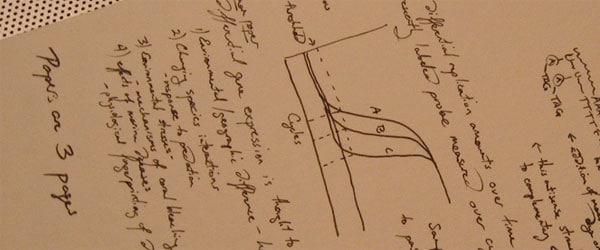So, you’ve designed PCR primers to amplify your sequence of interest, and you’re ready to go. But unless you have a never-ending supply of template, polymerase, and a thermocycler with a gradient function—not to mention a hefty dose of time and patience—you probably don’t want to spend the next week finding the perfect conditions for your PCR. Here are some tips to get you there faster. (Although, the gradient function is pretty handy.)
Melting and Annealing Temperatures
The company that you order your oligo primers from will include the melting temperature, or Tm, in the documentation they send with the oligos. However, I’ve noticed that different companies estimate the Tm slightly differently, depending on the calculation they use. The OligoAnalyzer tool on the IDT website is really useful when determining the optimal annealing temperature to set in your PCR cycles. However, if you’d prefer to do it yourself, here is the equation:
Tm= 2(A+T) + 4(G+C)
Where A, T, G, and C equal the number of each of those bases in the primer sequence.
The melting temperature is affected by the buffer salt concentrations, pH, and primer concentration, but I’ve found this to be of minimal concern. Double check that any unwanted secondary structures have a melting temperature significantly below your ideal annealing temperature (Ta) (i.e., at least 10°C lower). This will prevent the oligos themselves from being amplified during the PCR. The OligoAnalyzer tool will also check for any secondary structures when designing oligos.
I recommend that the annealing temperature is set 3°C below the lowest melting temperature of your primers. For instance, if your forward primer has a Tm of 62°C and your reverse primer has a Tm of 61°C, I suggest starting with a Ta of 58°C.
If you are lucky enough to have access to a thermocycler with a gradient function and enough template to set up the PCR in duplicate or triplicate, I’d suggest trying a range of annealing temperatures and assessing which Ta provides the best results.
Using Touchdown PCR
One of my favorite tricks is the touchdown PCR method, in which your first few PCR rounds are at a higher annealing temperature. After each round (or two or three) the Ta is lowered by 1-2°C. I’ve had great success with this technique. So what does this look like?
Using the example above with the 62°C and 61°C melting temperatures, I’d set the Ta of the first two cycles at 63°C, the next two cycles at 62°C, then 61°C, 60°C, and 59°C, for a total of 10 cycles. Then, I’d proceed with 25 cycles at 58°C. The benefit of this technique is that the first few cycles are very stringent, so it’s very unlikely that any non-specific amplification will occur. Thus, when the annealing temperature becomes more permissive, there will already be a pool of your desired amplicon to out-compete any non-specific sequences for binding of your primers.
Make sure your thermocycler is changing temperatures accurately and efficiently. I’ve learned first hand how much time can be wasted trying to optimize PCRs on a machine that isn’t working properly. One sign that your thermocycler may not be functioning properly is that the reaction takes longer than usual. You can ensure everything is working by simply including a control sample with every run (i.e., primers, template, and buffer conditions that you previously verified).
DNA Template
Use high quality template! Also, using too much DNA will decrease the specificity of your reaction, increasing the amplification of unwanted products. Because PCR is so sensitive, try using as little DNA template as possible. Start with no more than 1 ng of DNA for plasmid templates, 10-40 ng of cDNA, or up to 1 μg for genomic DNA samples.
Extension time
Have you ever wondered who came up with that thermocycler protocol we all use? While the denaturation and annealing times remain rather constant across the board, the extension time can vary significantly based on the size of amplicon you are generating. The general rule of thumb is to allow for a 60 second extension time per 1 kb of your amplicon. For example, if you are amplifying a 2 kb fragment, you’d program a 120 second extension time per cycle. For shorter amplicons, reduce the extension time. For a 200 bp amplicon, an extension time of 15 to 20 seconds is sufficient. Too long of an extension time can introduce unwanted products!
Polymerase choice
Taq DNA polymerase is used most frequently for PCR. Pyrococcus furiosus (PFU) polymerase is also commonly used for PCR and carries a lower error rate than Taq polymerase. However, there are other enzymes that work more or less efficiently for various templates. For instance, if your template region of interest contains a high G-C content (over 65%), then an enzyme such as Accuprime G-C Rich DNA Polymerase from Thermo Scientific may work better for your PCR.
Buffer components
When you purchase your polymerase enzyme, an optimized buffer will likely accompany it. Using this buffer according to the manufacturer’s instructions is your best bet. However, it is important to understand the components of that buffer and their contributions to the PCR efficiency. Most buffers are simply a combination of salts—such as KCl and MgCl2—at an optimal pH.
Magnesium
Magnesium concentration can be manipulated to alter the efficiency and fidelity of the PCR. For Taq DNA polymerase, the optimal magnesium concentration is 1.5 to 2 mM. Because other buffer and reaction components may chelate the magnesium, it may be necessary to increase the magnesium concentration. When modifying this concentration, make small adjustments (approximately 0.5 mM additions).
Primers
One could spend all day discussing the optimal design for PCR primers (length, G-C content, melting temperature pairing, secondary structures, and more). However, here, I’d like to simply mention the importance of optimizing their concentration in the PCR. If you add too much primer, there is an increased likelihood for non-specific binding or even primer-dimer pairing. As a general rule, stay below a total primer concentration of 1 μM. To increase specificity, this can be decreased to as low as 0.1 μM, however, this may reduce PCR yield.
dNTPs
The concentration of deoxynucleotides (dNTPs) can affect both the specificity and yield of your PCR. Too high a dNTP concentration will decrease specificity, while too low will decrease yield. For my purposes, yield is much less important than specificity, so I use 50 μM dNTP concentrations for most of my reactions. However, you can increase this concentration up to 200 μM to increase yield.
Hopefully these tips will get you through PCR optimization quickly and painlessly.
Best of luck!






